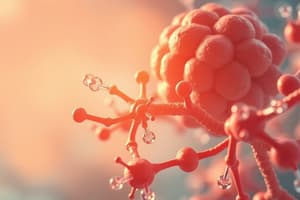Podcast
Questions and Answers
What is the primary function of photosynthesis?
What is the primary function of photosynthesis?
- Converts light energy to chemical energy (correct)
- Stores energy in ATP
- Absorbs oxygen from the atmosphere
- Breaks down glucose to release energy
Where does cellular respiration predominantly occur in eukaryotic cells?
Where does cellular respiration predominantly occur in eukaryotic cells?
- Chloroplasts
- Golgi apparatus
- Endoplasmic reticulum
- Cytoplasm and mitochondria (correct)
Which of the following are the main products of photosynthesis?
Which of the following are the main products of photosynthesis?
- Glucose and energy
- C₆H₁₂O₆ and ATP
- C₆H₁₂O₆ and O₂ (correct)
- CO₂ and H₂O
What is the role of chlorophyll in photosynthesis?
What is the role of chlorophyll in photosynthesis?
Which statement accurately describes anaerobic respiration?
Which statement accurately describes anaerobic respiration?
What is the main reactant in photosynthesis?
What is the main reactant in photosynthesis?
How does cellular respiration differ from photosynthesis in terms of energy dynamics?
How does cellular respiration differ from photosynthesis in terms of energy dynamics?
Which structure in the chloroplast is specifically involved in capturing light energy?
Which structure in the chloroplast is specifically involved in capturing light energy?
What is the primary function of chlorophyll in photosynthesis?
What is the primary function of chlorophyll in photosynthesis?
Which type of light does chlorophyll NOT absorb effectively?
Which type of light does chlorophyll NOT absorb effectively?
During which phase of photosynthesis is oxygen produced?
During which phase of photosynthesis is oxygen produced?
What is the role of NADPH in photosynthesis?
What is the role of NADPH in photosynthesis?
What are the two main sets of reactions in photosynthesis?
What are the two main sets of reactions in photosynthesis?
Which statement best describes autotrophs?
Which statement best describes autotrophs?
What happens to carbon dioxide in the Light Independent Reactions?
What happens to carbon dioxide in the Light Independent Reactions?
Where do the Light Dependent Reactions take place within the chloroplast?
Where do the Light Dependent Reactions take place within the chloroplast?
What is the primary role of electron carriers in biochemical reactions?
What is the primary role of electron carriers in biochemical reactions?
Which type of organisms are capable of photosynthesis?
Which type of organisms are capable of photosynthesis?
During which phase of photosynthesis is oxygen released?
During which phase of photosynthesis is oxygen released?
What pigment in the chloroplasts is primarily responsible for capturing solar energy?
What pigment in the chloroplasts is primarily responsible for capturing solar energy?
What is a key product of the light dependent reactions of photosynthesis?
What is a key product of the light dependent reactions of photosynthesis?
Which statement accurately describes chlorophyll's behavior in relation to light absorption?
Which statement accurately describes chlorophyll's behavior in relation to light absorption?
In the light independent reactions, what happens to carbon dioxide?
In the light independent reactions, what happens to carbon dioxide?
Which of the following is NOT a type of electron carrier mentioned?
Which of the following is NOT a type of electron carrier mentioned?
Flashcards
Cellular Respiration
Cellular Respiration
A process that breaks down glucose to release energy for the cell.
Photosynthesis
Photosynthesis
Converts light energy to chemical energy, creating glucose.
Autotroph
Autotroph
An organism that makes its own food.
Heterotroph
Heterotroph
Signup and view all the flashcards
Chloroplast
Chloroplast
Signup and view all the flashcards
Glucose
Glucose
Signup and view all the flashcards
ATP
ATP
Signup and view all the flashcards
Mitochondria
Mitochondria
Signup and view all the flashcards
Chlorophyll
Chlorophyll
Signup and view all the flashcards
Light-dependent reactions
Light-dependent reactions
Signup and view all the flashcards
Light-independent reactions (Calvin Cycle)
Light-independent reactions (Calvin Cycle)
Signup and view all the flashcards
Electron Carrier
Electron Carrier
Signup and view all the flashcards
What does NADPH do in photosynthesis?
What does NADPH do in photosynthesis?
Signup and view all the flashcards
How does NADPH work?
How does NADPH work?
Signup and view all the flashcards
What is the role of chlorophyll in photosynthesis?
What is the role of chlorophyll in photosynthesis?
Signup and view all the flashcards
Light Reactions
Light Reactions
Signup and view all the flashcards
What is the Calvin Cycle?
What is the Calvin Cycle?
Signup and view all the flashcards
What is the difference between autotrophs and heterotrophs?
What is the difference between autotrophs and heterotrophs?
Signup and view all the flashcards
Study Notes
Key Structures and Functions
- Chloroplasts are organelles in plant cells where photosynthesis occurs. They contain thylakoids and stroma.
- Mitochondria generate ATP through cellular respiration. They have inner and outer membranes, cristae, and matrix.
- Stomata are small openings on leaves that allow gas exchange (opening during the day for CO2 intake and closing at night to conserve water).
- Vascular tissue (xylem and phloem) comprises the xylem that transports water and minerals, and the phloem that transports sugars.
Enzyme Functions
- Enzymes are biological catalysts that speed up chemical reactions by lowering activation energy.
- Competitive inhibition occurs when an inhibitor competes with the substrate for an enzyme's active site.
- Non-competitive inhibition occurs when an inhibitor binds to an enzyme at a site other than the active site, altering its function.
Facts to Memorize
- Photosynthesis equation: CO2 + H2O + light energy → C6H12O6 + O2
- Cellular respiration equation: C6H12O6 + O2 → CO2 + H2O + ATP
- Main ATP production in cellular respiration occurs in the electron transport chain (ETC).
- Chlorophyll absorbs primarily blue and red light wavelengths.
Reference Information
- Light-dependent reactions occur in the thylakoid membranes and produce ATP and NADPH.
- Light-independent reactions (Calvin cycle) occur in the stroma and produce glucose.
- Glycolysis occurs in the cytoplasm, the Krebs cycle in the mitochondrial matrix, and the ETC in the inner mitochondrial membrane.
Concept Comparisons (Photosynthesis vs Cellular Respiration)
- Photosynthesis converts light energy into chemical energy, storing it in glucose.
- Cellular Respiration breaks down glucose to release energy.
- Photosynthesis reactants: CO2, H2O, light energy.
- Cellular Respiration reactants: C6H12O6, O2
- Photosynthesis products: C6H12O6, O2
- Cellular Respiration products: CO2, H2O, ATP
- Photosynthesis location: Chloroplasts (thylakoids and stroma)
- Cellular Respiration location: Mitochondria (cytoplasm and matrix)
- Photosynthesis energy storage: Stores energy in glucose
- Cellular Respiration energy release: Energy released from glucose
Steps of Cellular Respiration
- Glycolysis: Breaks down glucose into 2 pyruvate, producing 2 ATP and 2 NADH in the cytoplasm.
- Krebs Cycle: This cycle uses acetyl CoA to produce CO2, 2 ATP, 6 NADH, and 2 FADH2 in the mitochondrial matrix.
- Electron Transport Chain (ETC): Uses O2 to produce H2O and generates 32-34 ATP in the mitochondrial membrane
Energy Yield
- Total ATP yield from one glucose molecule is approximately 36-38 ATP (2 from glycolysis, 2 from Krebs cycle, 32-34 from the ETC).
- Aerobic respiration is more efficient in energy production than anaerobic processes
Fermentation Processes
-
Anaerobic respiration, in the absence of oxygen; cells generate energy through fermentation; allowing glycolysis to continue regenerating NAD⁺.
-
Fermentation happens in organisms living in oxygen-poor environments or during intense exercise.
-
Types of fermentation:
- Alcoholic fermentation: 2 pyruvate → 2 ethanol and 2CO2 (yeast in brewing and baking)
- Lactic acid fermentation: 2 pyruvate → 2 lactate (muscle cells during strenuous exercise and some bacteria)
Photosynthesis Overview
-
Photosynthesis: Autotrophs convert solar energy to chemical energy stored in glucose in the chloroplasts.
-
Chloroplasts contain thylakoids (stacked in grana) where chlorophyll absorbs sunlight.
- Chlorophyll types (a and b) absorb blue and red light and reflect green.
-
Two sets of reactions:
- Light reactions (in thylakoid membranes): Water is split, oxygen is released, ATP and NADPH are produced.
- Calvin cycle (in stroma): ATP and NADPH are used to convert carbon dioxide into glucose
Enzymes and Chemical Reactions
- Chemical reactions transform reactants into products, involving changes in chemical bonds.
- Reactants are starting materials. Products are the substances formed after the reaction.
- Spontaneous reactions release energy without external input; nonspontaneous reactions require energy.
- Activation energy is the minimum energy required for a reaction to start.
- Enzymes are biological catalysts; they accelerate reactions by lowering activation energy.
- Enzymes can be denatured by extreme conditions (high heat, extreme pH, salinity), losing their functionality.
Studying That Suits You
Use AI to generate personalized quizzes and flashcards to suit your learning preferences.
Related Documents
Description
This quiz covers key structures like chloroplasts and mitochondria, as well as their functions in photosynthesis and cellular respiration. It also explores enzyme actions, including competitive and non-competitive inhibition. Test your understanding of these fundamental biology concepts!




